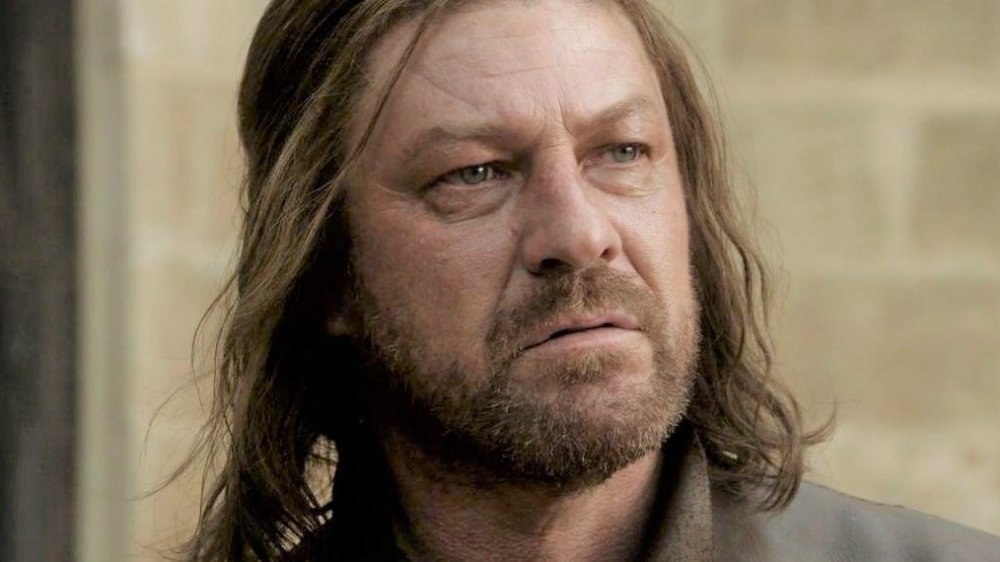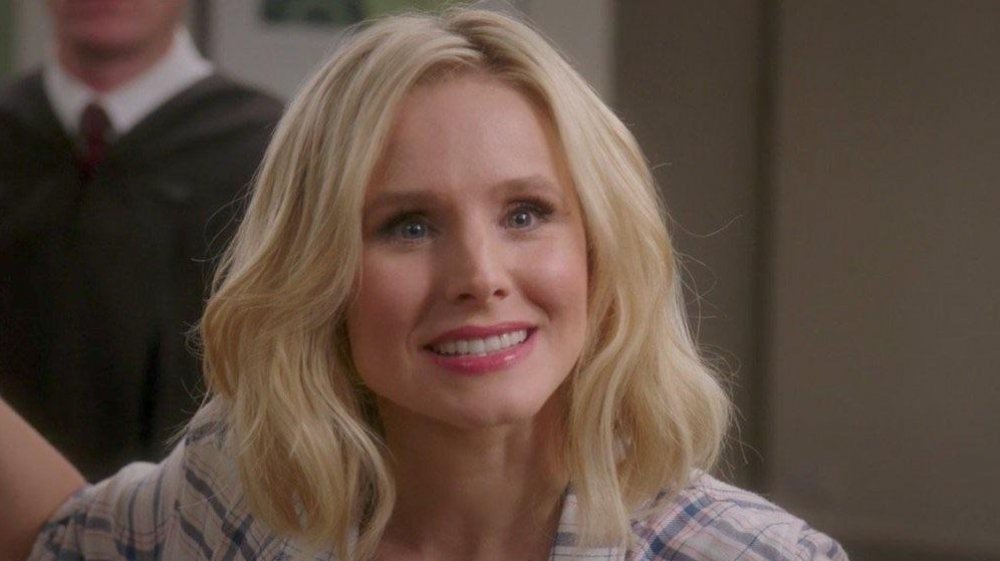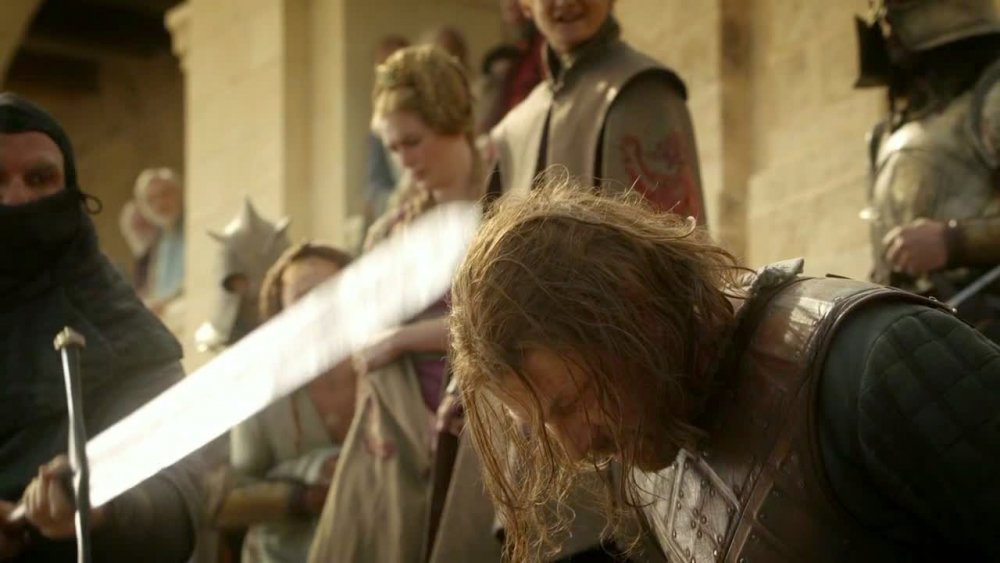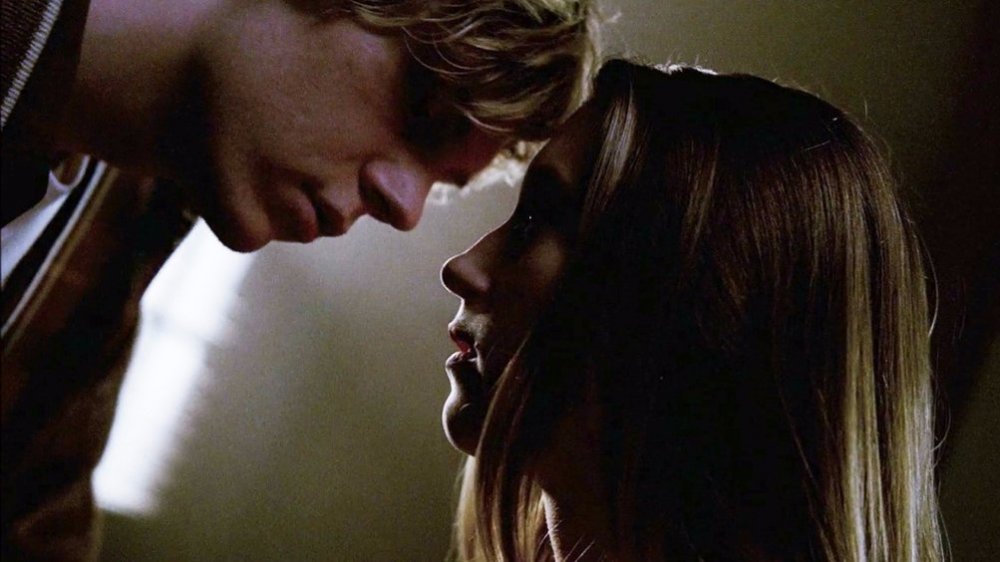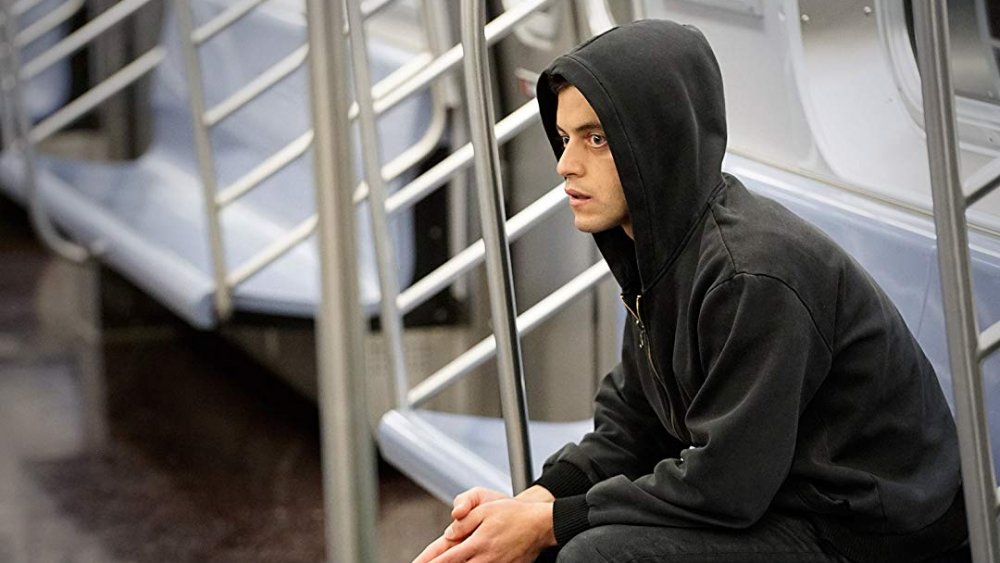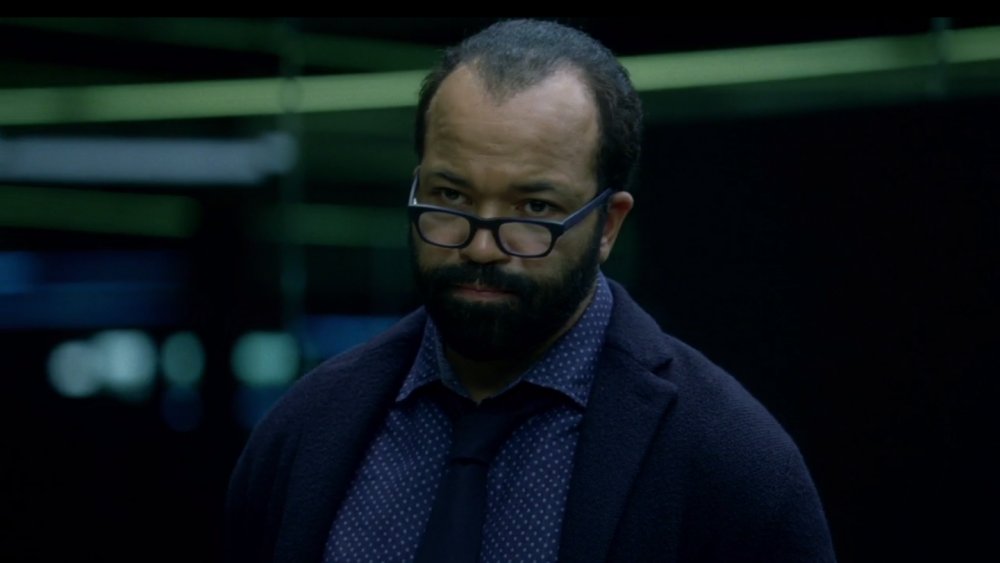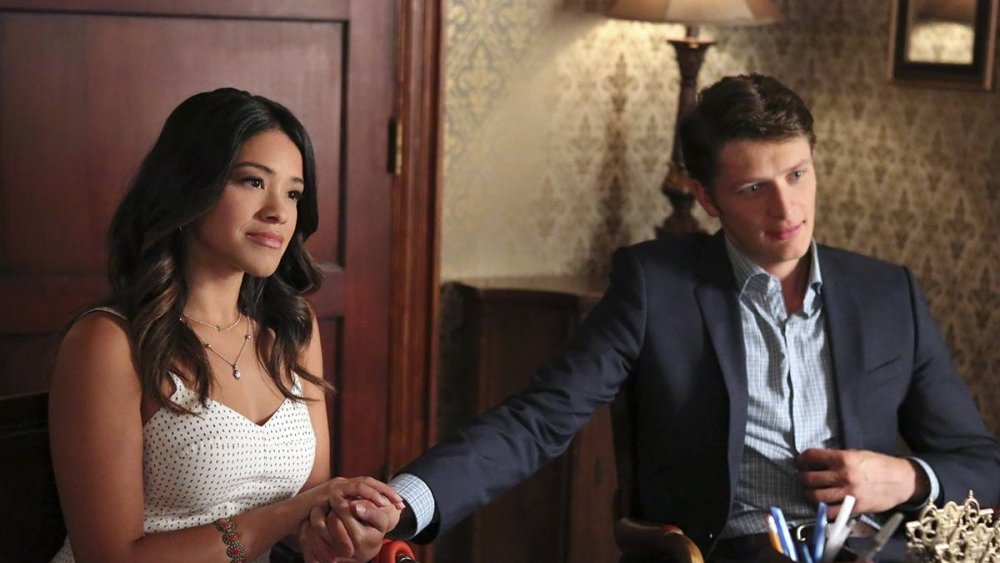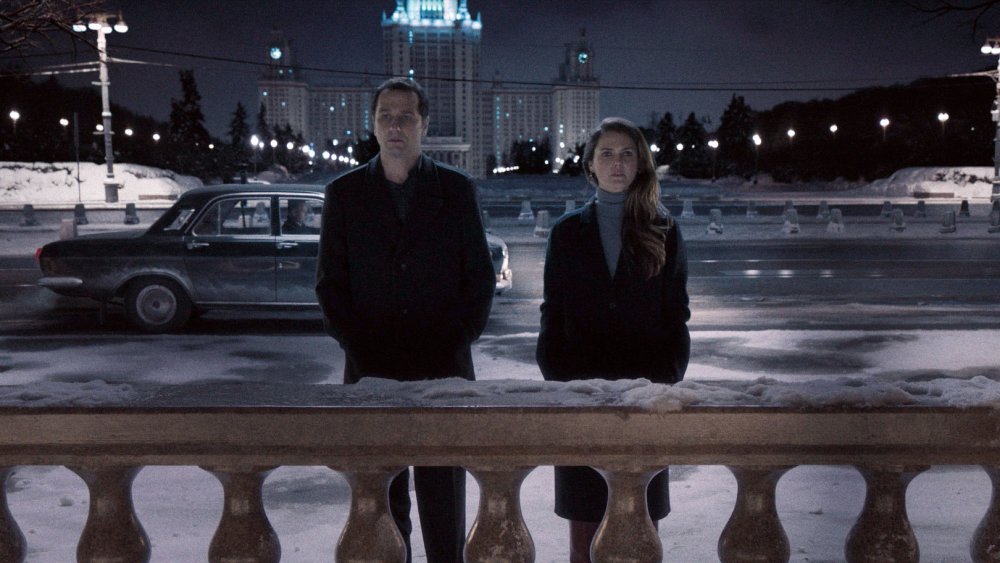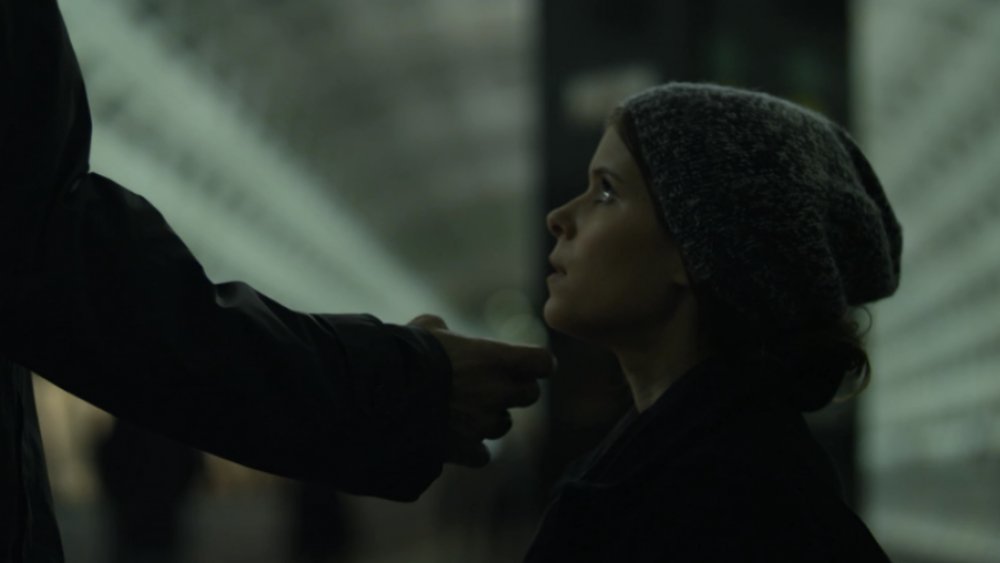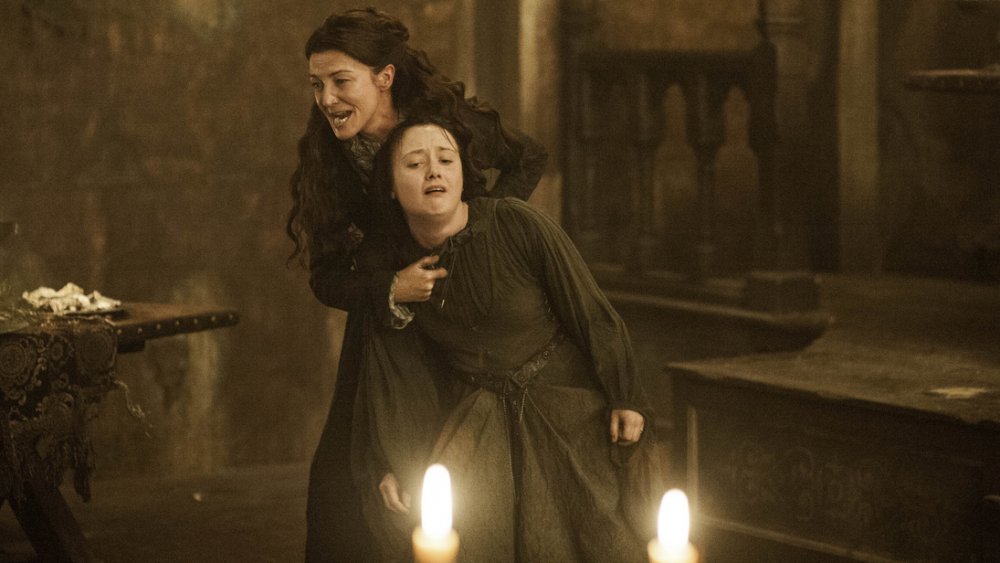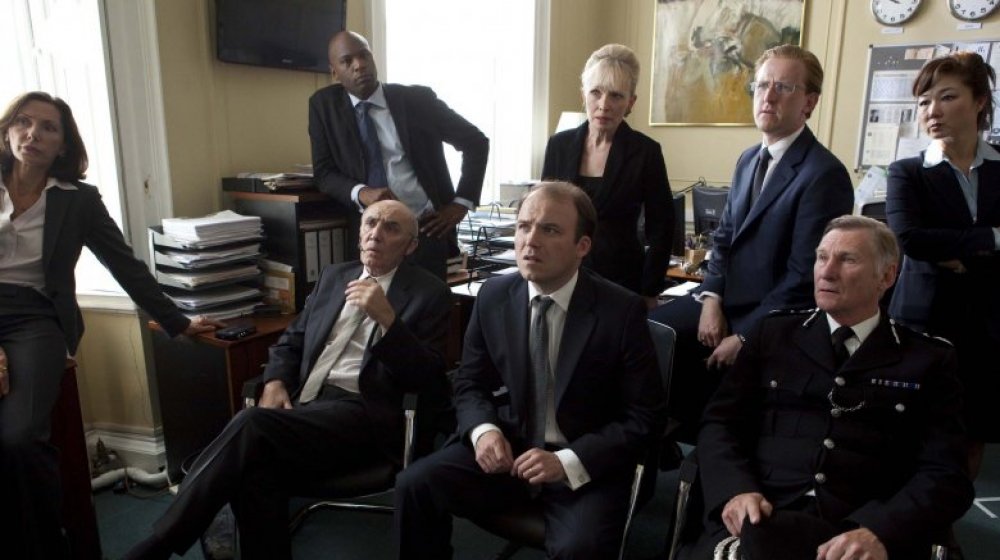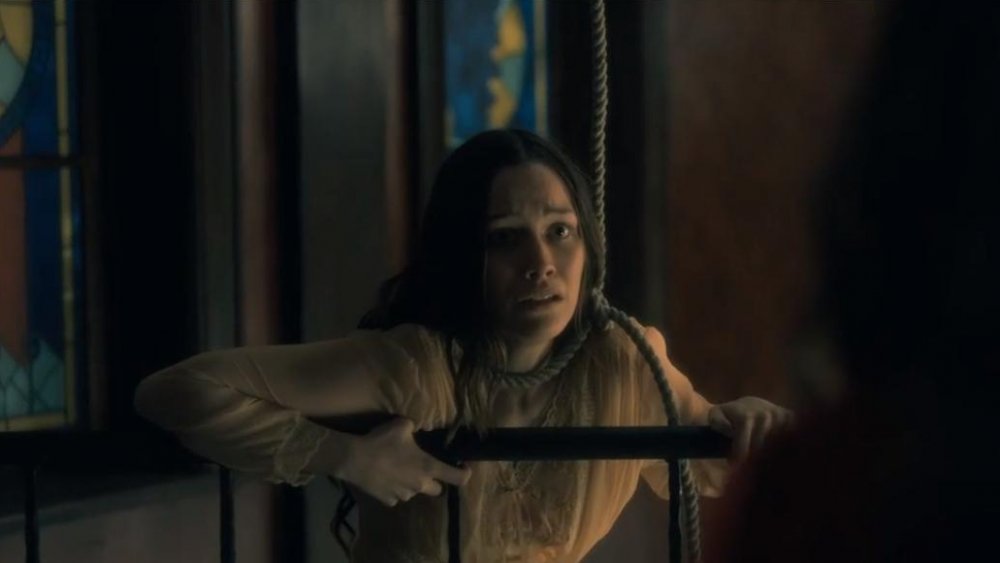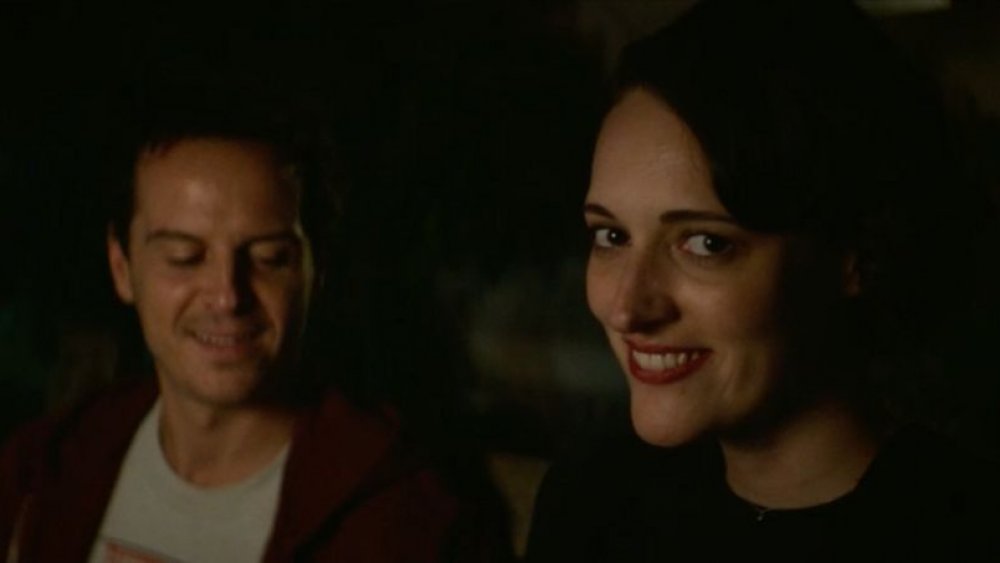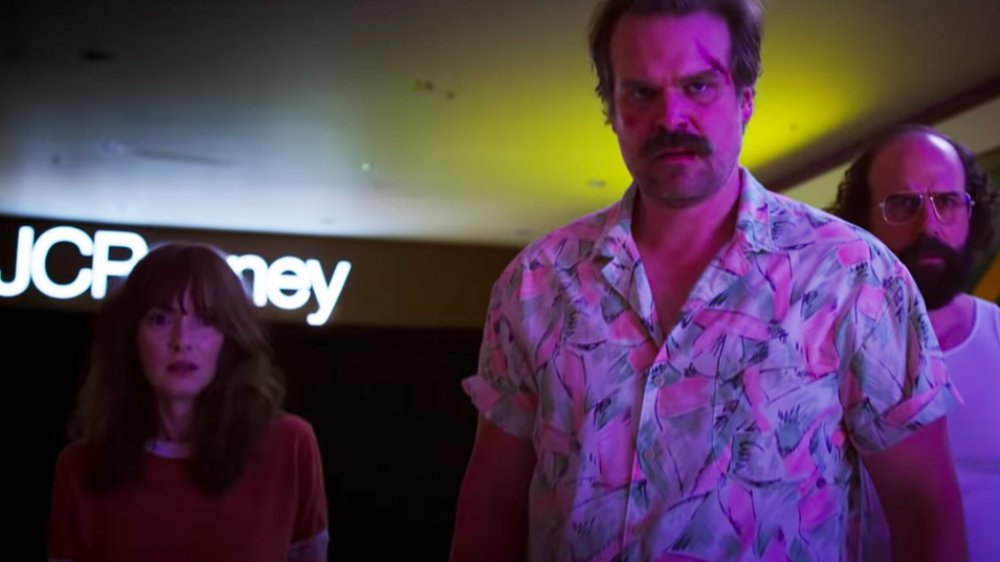The Best TV Twists Of The Last Decade
While plenty of great TV shows aired during the last decade, some of them offered up twists, tricks, and turns to keep their fans guessing, rather than pursuing a more straightforward path. By giving audiences well-earned surprises every now and then, these shows kept viewers on their toes throughout their viewing experiences, ultimately providing the 2010s with some of the small screen's most unforgettable moments.
From sprawling fantasy epics and modern telenovelas to anthology shows and network sitcoms, these twists are the most surprising, unexpected turns in this last decade of television, scenes that shocked and thrilled fans of each of these shows. Of course, it should go without saying that if you're behind on any of these shows, you might want to turn back now. To really get into the details of why these twists work so perfectly, we'll have to reveal them, so major spoilers lie ahead! But if you're okay with that, then keep reading for the best TV twists of the last decade.
Something's rotten in The Good Place
When viewers first meet The Good Place's Eleanor Shellstrop (Kristen Bell), she's immediately welcomed to her new eternal home by the seemingly angelic Michael (Ted Danson). After telling her the bad news — she's dead — Michael consoles Eleanor by telling her that thanks to her litany of good deeds back on Earth, she's officially landed in the Good Place, rather than, well, the Bad Place. As he shows Eleanor her new home, Michael introduces her to her neighbors Tahani (Jameela Jamil), Jianyu (Manny Jacinto), the neighborhood's all-knowing supercomputer Janet (D'Arcy Carden), and Eleanor's "soulmate," Chidi (William Jackson Harper).
However, the very first season of Michael Schur's afterlife comedy is chock-full of surprises. Eleanor immediately reveals to Chidi that there's been a mistake, and she definitely doesn't belong in the Good Place, and neither does "Jianyu," who's actually Jason, a dirtbag Florida DJ. But the biggest twist comes at the very end, when Eleanor is told she must be sent to the Bad Place for real. However, as everyone bickers and argues over who will go where, Eleanor has an epiphany: They've been in the Bad Place this whole time, and they're simply torturing one another. And, oh yeah, Michael is a demon. This explosive discovery is just a drop in the bucket when it comes to all the wacky places The Good Place goes, but it's the first great twist of the show, and Michael's evil laugh is just the cherry on top.
Ned loses his head in Game of Thrones
If you'd never read George R.R. Martin's sprawling fantasy series A Song of Ice and Fire before its HBO adaptation, Game of Thrones, you probably thought that Ned Stark (Sean Bean) was the story's protagonist. As the noble and honest Warden of the North, Ned is called to King's Landing during Thrones' inaugural season to serve as the Hand of the King to his old friend, Robert Baratheon. But before long, Ned lands himself in hot water by (correctly) suggesting that Robert's son and heir, Joffrey (Jack Gleeson), isn't Robert's son at all but the illegitimate child of Queen Cersei Lannister (Lena Headey) and her twin brother, Jaime (Nikolaj Coster-Waldau).
Joffrey, who's crowned king after Robert's sudden death, tells his advisors and the Stark family that he will show Ned mercy by simply banishing him to serve in the punitive Night's Watch, but when the young king brings Ned before the city, he announces that no mercy will be shown, beheading the Stark patriarch in front of Ned's two young daughters, Arya (Maisie Williams) and Sansa (Sophie Turner), instilling a thirst for revenge in both of the Stark girls. Game of Thrones would become notorious for subverting expectations, but Ned losing his head was its first truly great twist.
Violet's twisty secret in American Horror Story
One of the great anthology shows of the decade, Ryan Murphy's American Horror Story got off to an excellent start in 2011 with its first season, a classic retelling of a haunted house fable that was later subtitled Murder House. The plot centers around the Harmon family — Vivien (Connie Britton), Violet (Taissa Farmiga), and Dr. Ben Harmon (Dylan McDermott) — who move into an old, mysterious house in California, only to discover there are definitely some pretty shady supernatural happenings hidden within. Add their overly involved neighbor, Constance (Jessica Lange), and you've got a pretty tough living situation, which keeps the teenaged Violet in a terrible mood throughout the beginning of the series. Luckily, she finds a friend and ally in Tate (Evan Peters), a troubled young boy she meets shortly after the move.
Halfway through the season, Violet attempts suicide before Tate saves her, but unfortunately, she later finds out that her attempt went quite differently. In a heartbreaking scene, Tate, who turns out to be a ghost of the house himself, shows her how much they have in common by showing Violet her own body in the house's crawlspace. Yeah, she's a ghost too, and the two of them are trapped on the property together forever.
Mr. Robot isn't what he seems
In 2015, writer and director Sam Esmail gave future Academy Award winner Rami Malek an extraordinary opportunity by casting him in Mr. Robot, the highly ambitious and layered drama series. During its first season, audiences meet Elliot Alderson (Malek), a socially inept engineer and hacker who teams up with a group of other underground computer experts to overthrow the government. Elliot is initially brought on board by the enigmatic and mysterious Mr. Robot (an excellent Christian Slater), who mentors him throughout the season.
However, as it turns out, there's much more to Mr. Robot than meets the eye — specifically, Elliot's eye, as Eliot is the only one who can see him in the first place. The character played by Slater isn't actually there. Instead, Elliot is disassociating and seeing his dead father, and as it turns out, Elliot is actually leading the hacking effort himself as Mr. Robot. Sounds pretty confusing, right? It is, but Esmail lays it all out perfectly, creating an unforgettable twist.
Hidden hosts in Westworld
HBO's Westworld, adapted from Michael Crichton's film of the same name, presents a futuristic world in which the richest members of society can escape their lives (for a price) by spending time at the titular park, which offers a fully immersive, seemingly authentic Western experience. Populated by accommodating "hosts," which are really just extremely realistic robots designed to provide the perfect guest experience, Westworld seems like a paradise ... until those hosts begin to gain sentience and try to figure out how to escape their confines at any cost.
Westworld is home to a whole host (pun intended) of characters, but one of the most important is Bernard (Jeffrey Wright), who programs the software to keep the hosts running and involved in their fake storylines. Throughout the first season, he primarily interacts with Dorothy (Evan Rachel Wood), the park's oldest host who's struggling to find her real memories. But eventually, the audience discovers something extremely surprising about Bernard. The programmer isn't a Westworld worker at all but a host himself, programmed to contain the consciousness of park co-founder Arnold Weber. Westworld is known for its constantly twisting narrative, so it says something that Bernard's true nature was such a surprise.
A return from the dead on Jane the Virgin
When a new show is adapted from a popular telenovela, a genre characterized by its plot twists, you can probably expect some serious turns and surprises. This is definitely the case with Jane the Virgin, a fizzy yet carefully mapped CW series which is a (fairly loose) adaptation of a Venezuelan drama called, naturally, Juana la Virgen. The woman behind Jane, Gina Rodriguez — who won a Golden Globe for her performance in 2014 — brings real heart and truth to her role as a 23-year-old virginal woman who's accidentally artificially inseminated during a routine visit to the gynecologist.
This insane life development is troubling for several reasons, not the least of which is that it throws a serious wrench into Jane's relationship with her boyfriend Michael (Brett Dier), but despite a love triangle with the baby's biological father, Rafael (Justin Baldoni), the two eventually get married. Tragically, Michael dies in the third season from an aortic dissection from a previous gunshot, which he sustained in the line of duty as a detective. But from the transition from the fourth season to the fifth, audiences were shocked to learn that Michael wasn't only still alive but suffering from memory loss and living as "Jason." In a show that features surprise twins, mistaken identities, and even an all-seeing narrator, it's remarkable that Michael's return from the dead was Jane's most shocking development.
The Americans get their freedom in one of the decade's best finales
Over five years and six season, FX's The Americans told the gripping, twisting story of Elizabeth and Philip Jennings (played by real-life couple Keri Russell and Matthew Rhys), two Russian spies sent to infiltrate the American government during the fraught environment of the Cold War. As they try to raise their children — who initially don't know anything about their parents' deception — and navigate their lives as false Americans, they must also keep up appearances with their neighbor, Stan (Noah Emmerich), who just so happens to be an FBI agent with a specialization in counter-intelligence.
Eventually, it all comes to a head, and the truth becomes unavoidable. In one of the best series finales in TV history, "START," Philip and Elizabeth confess to Stan and tell him that they've been Soviet spies all along. Despite his allegiance to the FBI, Stan lets the entire family go in a heartbreaking scene where he realizes that his best friend in the world was working against him and his country for their entire friendship.
House of Cards takes a fateful train
One of Netflix's first forays into original content, House of Cards, created by Beau Willimon and adapted from the 1990s BBC miniseries of the same name, had all the makings of serious, prestige television. With a pilot directed by David Fincher and a core cast that included Kevin Spacey and Robin Wright, House of Cards painted Washington D.C. as a dirty, scandal-ridden town filled with people who will do just about anything to gain more power.
And as Frank Underwood, a man who would stop at nothing to climb the political ladder, Kevin Spacey — who was later fired from the show over several accusations of sexual assault and harassment from throughout his career — clearly had no limits where wrongdoing was concerned, which came to a head during the show's second season. During an argument with Zoe Barnes (Kate Mara), a young reporter he's having an affair with, Frank realizes there's no way to keep her quiet, and after he tricks her into going into an empty metro station, he shoves her in front of a train without a second thought. With one push, House of Cards set a standard for shock value in prestige dramas, and though it ultimately never matched other shows like Mad Men or Breaking Bad, this jaw-dropping moment was entirely unforgettable.
Game of Thrones takes the decade's bloodiest twist at the Red Wedding
After Ned Stark lost his head, it was clear that Game of Thrones would be full of shocking, disturbing moments, and though loyal readers of George R.R. Martin's series knew they should prepare themselves for the Red Wedding, it still felt like a gut punch to Martin experts and Thrones newbies alike. In the show's third season, after Robb Stark (Richard Madden) breaks an engagement with the daughter of one of his political allies, Walder Frey (David Bradley), he attends the wedding of the same daughter, along with his new wife (Oona Chaplin) and his mom, Catelyn (Michelle Fairley). Naturally, the trio expects a warm welcome, but that's not exactly how things turn out.
Walder Frey seems forgiving at first, but once the marriage ceremony is done, the episode features one heartbreaking moment after another. When Catelyn sees the doors suddenly lock behind them, she fears the worst, and she's right. Walder's men repeatedly shoot and stab Robb, and they attack his pregnant wife, stabbing her swollen stomach in one of the most grotesque scenes ever committed to film. And as Catelyn holds one of Walder's daughters captive in exchange for Robb, Roose Bolton, a Lannister ally, kills the young king of the north, so Catelyn slits the young girl's throat before her own is cut in a silent, staggering moment that remains one of the most harrowing and unforgettable sequences in all of Thrones.
Black Mirror starts with a shocker
Charlie Brooker's anthology series Black Mirror, which originally aired on Britain's Channel 4 before moving exclusively to Netflix in 2015, tackles an important and incredibly relevant question for the modern age. As technology keeps advancing, what should we all be afraid of? Turns out, the answer is "most things," from Google Glass-style eye implants and Star Trek-inspired alternate realities to real-life social media ranking systems.
Pretty much any episode of Black Mirror, from its groundbreaking "Bandersnatch" to its heart-wrenching "San Junipero," provides an earth-shattering twist, but to get a good idea of what the show is all about, check out its very first episode, "The National Anthem." In the series premiere, the British Prime Minister (Rory Kinnear) is given a choice. He can have sexual intercourse with a pig on live television, or a kidnapped member of the royal family will be killed. After a harrowing process, he decides to go through with it, only to be told that the "missing" princess had been released before he aired his act with the pig. Black Mirror set out to be a bleak look at modern technology right out of the gate, and stomach-turning as it might be, "The National Anthem" and its twist set the standard for the entire series.
The Bent-Neck Lady's identity is revealed in one of TV scariest twists
Based on Shirley Jackson's 1959 classic horror novel, Netflix's 2018 adaptation of The Haunting of Hill House arrived just in time for Halloween that year, and it proved to be a scary, satisfying, and exciting addition to the streaming service's slate of original content. Set between two different timelines, Doctor Sleep's Mike Flanagan expertly helmed the story of the Crain family, who all experienced supernatural happenings at Hill House as children and who are all trying to escape their horrifying memories as adults.
Of all the Crain siblings, Eleanor, who goes by "Nell," still struggles with her experiences at Hill House as one of the youngest members of the family. (Well, as a twin, she's technically the youngest by a margin). She's particularly terrified by the memory of one ghost called "the Bent-Neck Lady" who haunts Nell more than anybody else. However, as it turns out, Nell is the Bent-Neck Lady. After returning to the house, she hangs herself on the property and is left to haunt it forever, even somehow traveling back in time to haunt her younger self.
Fleabag's fourth-wall surprise
Phoebe Waller-Bridge's award-winning, groundbreaking series Fleabag — which she created, wrote, and stars in — gave us one of the best TV characters of the last decade and is known for its foul-mouthed humor and perfect blend of pathos and comedy. However, it also bears one other important hallmark. Throughout the show's first season, the main character — who's only ever known as "Fleabag" — constantly breaks the fourth wall, letting Fleabag talk to the camera as if it's her closest friend in the world. It's important to note that nobody else ever notices or sees Fleabag confiding in her imaginary friend, until a new person arrives in her life who sees through her facade.
As the second season opens, Fleabag meets an important new person, the Priest (Andrew Scott), who's been personally handpicked to perform her father's second wedding. As the season progresses, the two strike up an unlikely friendship that threatens to become something more, despite the Priest's holy vows. Fleabag begins spending more and more time with the Priest, and before long, something interesting happens. He watches her break the fourth wall and comments on it, asking where she "goes" and even looking directly into the camera himself as if searching for Fleabag's mysterious friend. After so much time with just Fleabag, it's incredibly jarring for another character to share her control over the fourth wall, but it also shows how much the Priest understands her, adding a seriously heartbreaking layer to their ultimately doomed relationship.
Hopper's possible sacrifice in Stranger Things
Throughout the run of Netflix's smash hit Stranger Things, David Harbour has become a fan favorite thanks to his role Chief Jim Hopper, the head of the police department in Hawkins, Indiana, who finds himself investigating strange supernatural happenings. After suffering a terrible loss — namely, losing his young daughter to cancer — Hopper turned to alcohol for relief, but eventually, thanks to loved ones like Joyce Wheeler (Winona Ryder) and adoptive daughter Eleven (Millie Bobby Brown), he turns his act around, becoming a caring boyfriend and a father figure, as well as an ally to everyone in Hawkins fighting the monsters from the Upside Down.
However, at the end of season three, it seems as if Hopper has made the ultimate sacrifice. After infiltrating a Russian military base with Joyce, Hopper apparently dies while successfully closing an open gate between Hawkins and the Upside Down, leaving his friends and family to mourn his death as the season draws to a close. Unsurprisingly, Harbour and the show's creators, the Duffer brothers, have both been extraordinarily tight-lipped about Hopper's potential return, but even so, it's shocking that they would put such a beloved character on the line, whether or not Hopper returns to Hawkins in the end.
